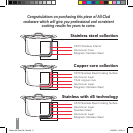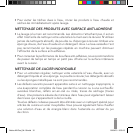
• Because All-Clad pans distribute heat quickly and evenly, you may nd cooking
with a lower heat setting is sufficient. There is no need to preheat your pan
for more than one minute.
• Never overheat your pan as this may cause a blue or yellow discoloration. In
order to know if your pan has reached the right temperature, you can choose
one of the following tests :
- The water drop test : let a water drop fall into the pan. If the water drop
forms a marble that easily rolls and moves all over the surface of the pan,
then it is ready for the ingredients. If the water drop splashes on to the pan
surface, then continue to heat your pan and do the test again.
- The butter test : rub a teaspoon of butter over the inside of the pan. When
the butter bubbles briskly (it should not turn brown), it is ready for the
ingredients. If the butter turns brown, the heat setting is too high.
• In general, overheating can cause the emission of fumes from pans and food.
By following these care instructions, you will prevent the emission of fumes
from pans and food that have been overheated. These fumes could be
dangerous for animals with very sensitive respiratory systems such as birds.
We recommend that birds should not be kept in the kitchen.
• If the cookware is accidentally overheated the pan should not be moved but
should be left to cool first.
• Do not allow handles to come into direct contact with heat or ames as they
may get hot.
• To avoid the formation of small white dots or pits on stainless steel interiors,
bring liquids to a boil before adding salt, then stir well. Or, add salt after food
has started to cook. Pitting does not interfere with cooking performance but
can diminish the beauty of the stainless steel.
5
Notice All-Clad_04-10.indd 5 16/04/10 9:03:11


















